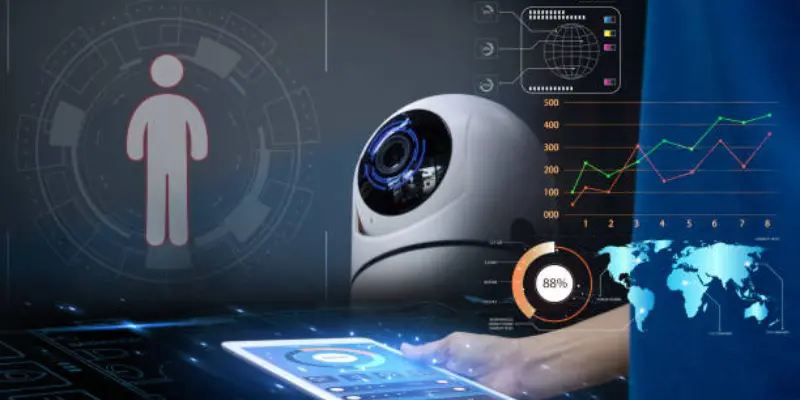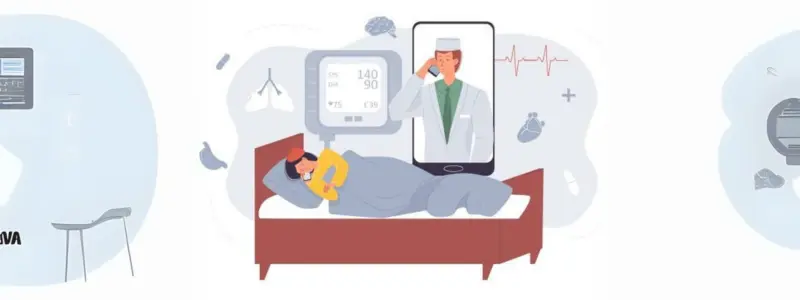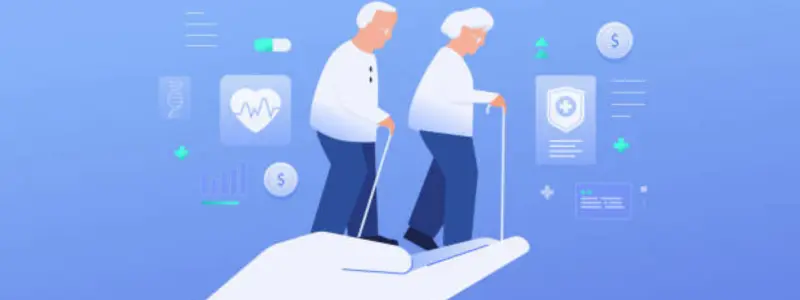AI-Powered Remote Monitoring Services: A Healthcare Revolution
Published: 30 May 2025
What if your doctor could check on your health without you going to the hospital? Sounds amazing, right? That’s what AI in remote monitoring is doing today. It’s changing how healthcare works by making it faster, easier and safer.
Remote monitoring means keeping track of a patient’s health from far away. With smart devices and artificial intelligence (AI), doctors can now watch your health in real time. They can even spot problems before you feel anything wrong.
This blog will help you understand how AI works in remote healthcare, who it helps, why it’s important and what can be possible challenges with this tech. Don’t worry—it’s all in simple words. Ready to see how this tech is making life better for patients and doctors? Let’s get started!

What Is Remote Monitoring in Healthcare?
Remote monitoring means checking a person’s health without visiting a clinic or hospital. It uses smart tools to collect health data while the patient stays at home. This data goes straight to doctors, nurses or health teams through the internet.
How Does It Work?
It starts with devices. These can be:
- AI Aided Wearables like smartwatches
- Patches that stick on the skin
- Home tools like blood pressure cuffs or glucose monitors
- Mobile apps that track sleep, steps or heart rate
These tools collect information like your heart rate, blood sugar, oxygen levels or even your daily movement. Then, they send the data to your doctor in real time.
Who Benefits from It?
Remote monitoring helps many people, especially:
- Seniors who live alone and need regular checkups
- Patients with long-term diseases like diabetes or heart problems
- People recovering after surgery who need daily tracking
Example: Imagine an elderly man living alone. He wears a smart wristband that checks his heart rate. One night, his heart beats too fast. The device sends a quick alert to his doctor. The doctor calls him right away and helps him get the care he needs, without delay.
The Role of AI in Remote Monitoring
Artificial Intelligence makes remote monitoring smarter and faster. It helps doctors understand health data quickly and take action before things get worse.
What Does AI Do?
AI looks at the data collected by smart devices. It finds patterns and spots any signs of trouble. It works 24/7 and sends alerts if something looks wrong.
For example, if your heart rate gets too high or your blood sugar drops suddenly, AI can send a warning to your doctor right away. It doesn’t get tired and never misses a beat.
Why Is AI Better?
Here’s why AI is a game changer:
- It finds problems early
- It handles large amounts of data fast
- It gives smart suggestions to doctors
- It works all the time, even when no one is watching
Key Tools Used in AI Remote Monitoring
- Machine Learning: This helps AI to learn from your past data. It gets smarter over time.
- Predictive Analytics: It guesses what might happen next, like a sudden drop in blood pressure.
- Chatbots and Virtual Assistants: These help in answering simple questions or remind you to take your medicine.
Real-Life Tip: Some smartwatches now track your sleep, heart rate and even stress levels. AI reads this data and helps you stay healthy by giving small, helpful tips each day.
Benefits of AI-Powered Monitoring
AI-powered remote monitoring is not just a fancy idea, it’s making real changes in everyday healthcare. Let’s look at how it helps different people in the system: patients, doctors and hospitals.
a. For Patients
AI gives patients more freedom, comfort and safety, all at the comfort of their own homes. Here’s how:
- Stay at home, feel cared for
You don’t need to travel for every checkup. You can rest at home while your doctor keeps an eye on your health from a distance. - Get help faster
AI spots warning signs early like a high heart rate or low oxygen level. It alerts your doctor right away. You get help before things get worse. - Feel more in control
With smart devices, you can track your own health daily. You will feel more involved in your care which builds confidence and peace of mind.
Example: A man with diabetes uses a small wearable patch that checks his blood sugar every hour. One night, it drops suddenly. The system alerts both him and his doctor. He gets a call in minutes and avoids a dangerous situation.

b. For Doctors
AI helps doctors work smarter, not harder. Here’s how it supports them:
- Saves time on routine tasks
AI checks data, finds problems and filters out false alarms. Doctors only get alerts that truly need attention. - Monitors many patients at once
One doctor can track hundreds of patients through an AI dashboard. It’s like having a smart assistant that never sleeps. - Gives data driven advice
AI tools help doctors make decisions based on real time data. This means better treatment and less guesswork.
Tip: Many doctors now use mobile apps that show health updates, color-coded alerts and patient notes, all in one place.
c. For Hospitals
Hospitals face pressure every day. AI makes their work easier and more efficient:
- Cuts down on hospital visits
When people are monitored at home, they don’t need to visit as often. This saves time, money and space. - Frees up beds and staff
Hospitals can focus on serious cases. Nurses and doctors can give better care when they are not overloaded. - Improves patient safety
Early detection means fewer emergencies. Patients get help before problems become life-threatening.
Real-Life View: During the COVID-19 crisis, hospitals in many countries used AI-powered remote monitoring to care for patients with mild symptoms at home. This kept hospital beds free for people who really needed them.
Real Life Use Cases of AI-Powered Remote Monitoring
AI-powered remote monitoring is already in action today. It’s not just saving time but is also saving lives. Here are some real stories and use cases that show how AI is transforming healthcare.
a. Managing Chronic Diseases
Chronic illnesses need daily attention. These include diabetes, heart disease, asthma and high blood pressure. In the past, patients had to visit the doctor often. Now, smart devices and AI make things easier and safer.
How it works:
- Patients wear a device or use an app that checks their vital signs regularly.
- AI studies the data and sends real-time updates to the healthcare team.
- If anything looks risky like a sudden spike in blood sugar, AI sends alerts right away.
Example:
A woman with diabetes wears a continuous glucose monitor (CGM). It checks her sugar every 5 minutes. One night, her sugar drops dangerously low while she sleeps. AI spots it and sends an alert to her phone and her doctor. She wakes up, drinks juice and avoids a diabetic emergency.
b. Caring for the Elderly at Home
Many elderly people live alone. They might forget to take medicine, eat poorly or even fall with no one around. AI-powered monitoring tools help them live safely at home with less worry.
Devices used:
- Smartwatches that track steps, heart rate and falls
- Pillboxes that alert when medicine is missed
- Motion sensors that track movement and activity levels

What AI does:
- It notices if someone is unusually still or misses medication.
- It sends alerts to family members or nurses if something feels “off.”
- It gives reminders and even voice messages for things like eating, walking or taking meds.
Example:
An 82 year old man has mild memory loss. He wears a smartwatch that tracks movement and heart rate. For two days, his activity drops and he skips meals. The AI system picks up the change and sends an alert to his daughter. She visits and finds he has a cold and has not been eating. They can call the doctor early, no hospital needed.
c. Post-Surgery Monitoring at Home
After surgery, doctors need to make sure patients heal well. Instead of staying in the hospital, many people now recover at home with AI keeping watch.
How it works:
- Patients wear smart patches or devices that track body temperature, swelling or movement.
- AI checks for signs of infection, bleeding or pain.
- If something goes wrong, it sends alerts instantly.
Example:
A woman has surgery on her knee. She wears a small patch that tracks swelling and skin temperature. On Day 4, the AI notices the temperature around the wound has risen which can be a possible sign of infection. The doctor calls her early. They treat the infection before it gets worse.
d. Supporting Mental Health
Mental health can be harder to track but AI is helping here too. Apps and smart tools now watch for patterns in sleep, mood and activity to catch early signs of stress or depression.
How it works:
- People log how they feel daily or wear trackers that notice sleep and movement.
- AI watches for long stretches of sadness, poor sleep or isolation.
- It sends gentle alerts or suggests talking to a counselor or taking a break.
Example:
A teenager uses a mental wellness app. Over two weeks, the app sees fewer social interactions, late-night phone use and low activity. The AI suggests a mental health check. The teen’s school counselor reaches out and offers support. The early help prevents the issue from growing.
e. Monitoring During Infectious Disease Outbreaks
Remote monitoring helped a lot during the COVID-19 pandemic. Patients with mild symptoms stayed home. AI tools kept an eye on their oxygen levels and breathing.
How it helped:
- Hospitals didn’t get overwhelmed.
- Patients stayed safe at home.
- Doctors could still act fast if a person’s oxygen dropped.
Example:
A middle-aged man has COVID-19. He uses a pulse oximeter at home. It tracks his oxygen levels and sends the data to his doctor. One night, the AI notices a drop in oxygen and alerts the medical team. He gets oxygen therapy at home and recovers safely, no ER visit needed.
Challenges and Limitations of AI-Powered Remote Monitoring
While AI-powered remote monitoring offers many benefits, it also faces some challenges:
- Privacy Concerns
- Patient data is very sensitive.
- Keeping data safe from hackers is a big worry.
- Hospitals must follow strict rules to protect privacy.
- Patient data is very sensitive.
- Technology Access
- Not everyone has devices like smartphones or wearables.
- People in rural or low-income areas may struggle to use AI monitoring.
- This can cause gaps in care.
- Not everyone has devices like smartphones or wearables.
- Accuracy and False Alarms
- AI may sometimes give false alerts.
- Too many false alarms can make doctors and patients ignore warnings.
- AI systems need constant updates to improve accuracy.
- AI may sometimes give false alerts.
- User Comfort and Training
- Some patients, especially older adults may find new devices hard to use.
- Training and support are needed for smooth adoption.
- Healthcare staff also need to learn how to use AI tools well.
- Some patients, especially older adults may find new devices hard to use.
- Cost of Devices and Services
- High-quality monitoring devices can be expensive.
- Insurance may not always cover AI monitoring costs.
- This limits access for some patients.
- High-quality monitoring devices can be expensive.
- Data Overload for Healthcare Providers
- Monitoring many patients generates lots of data.
- Doctors need efficient ways to handle alerts without feeling overwhelmed.
- Good AI design helps reduce “alert fatigue.”
- Monitoring many patients generates lots of data.
- Regulatory and Ethical Issues
- AI in healthcare must follow medical laws and guidelines.
- Decisions made by AI need to be transparent and explainable.
- Ethical concerns about relying too much on machines remain.
- AI in healthcare must follow medical laws and guidelines.
Conclusion
AI in remote monitoring is changing healthcare for the better. It helps patients stay safe at home, gives doctors real time information and improves care for many health conditions. While there are challenges like privacy and cost, the future looks bright with smarter devices and better AI tools.
Are you curious about how AI remote monitoring could help you or your loved ones? Staying informed and open to new technology can make a big difference in health.
Yes, some devices are made just for children to track their health safely from home.
They use smart software to prioritize alerts, so only urgent cases get quick attention.
Most devices save data and send it when the connection returns but a stable internet helps.
It can help spot warning signs early but in sudden emergencies, calling emergency service providers is still best.
Usually, devices last days to weeks on a charge or battery, depending on type and usage.
There is a small risk, so doctors always review AI alerts before making decisions.
Yes, AI can analyze sleep, activity and mood data from devices to spot early signs.
Most systems include easy instructions and offer phone or online support for questions.
Ignoring alerts can delay treatment, so it’s important to follow up with your doctor.
Most people learn quickly often within a day or two with help from guides or support teams.





